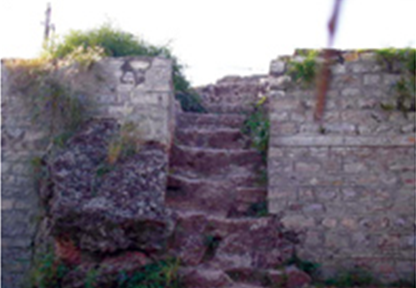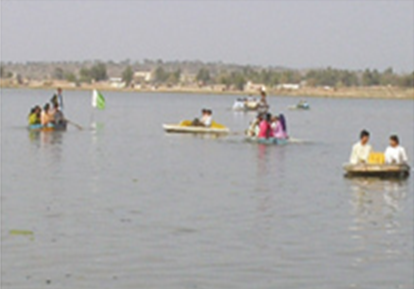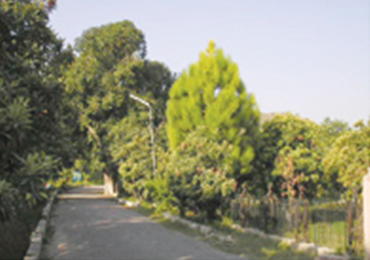Alai valley, Battagram tehsil
This is a collection of articles archived for the excellence of their content. Readers will be able to edit existing articles and post new articles directly |
Alai valley, Battagram tehsil, NWFP
Change for the better
By Zahrah Nasir
Remote Alai valley, located in Battagram tehsil, NWFP, was almost unknown outside its immediate area prior to the devastating earthquake of October 8, 2005. It was marked on few, if any, maps and outsiders, particularly foreigners, were actively discouraged from venturing into the valley which, in its upper reaches at least, was once home to a small Buddhist community.
The Pathan inhabitants, belonging to a small number of tribes, are extremely independent and hardworking by nature. Subsistence farming has always been the backbone of their frail economy and most cash money came in from men and young boys who ventured in to the ‘outside’ world to work.
The earthquake, Alai was in the centre of this terrible calamity, destroyed almost every single home in the long, narrow valley which is hemmed in by high mountains on all sides, totally severing the already tenuous road link with the Karokoram Highway at distant Thakot Bridge.
”It was eight days before help arrived,” says Zafar Shah, a resident of Diyar, a minute hamlet towards the far end of the valley. “A helicopter carrying a foreign TV channel’s film crew found us first and we were so delighted to see them that we cried in happiness. For the first time in our history we were pleased to have strangers here.”
Zafar lost over 60 close relatives. Coming to terms with the loss of lives, their homes and everything they possessed, was not an easy thing to do and Zafar had tears streaming down his face as he related the harrowing memories and the severe difficulties the people initially faced. “Then we realised that the need of the moment was to survive and, by the grace of God and the assistance of so many people, both from Pakistan as well as all over the world, the Pakistani Army and the government, we pulled ourselves together, buried our dead and tended to the living.”
In Alai, time is now divided into ‘before’ and ‘after’ the quake and, whilst the people obviously wish that the tragedy had never happened, they are set on making the most out of the opportunities being given them to rebuild and restructure their very existence.
”Things have changed in Alai since you first saw it before the quake,” Kamran Shah, another inhabitant of Diyar tells me. “It is very different from when you built your own house in the village. When we were there we had to walk on a long dirt track to reach our homes. The dirt track and all the roads in the valley disappeared in the quake but now the government and an NGO have given us proper roads, so access is easy,” he continued with a smile on his face.
”While rebuilding the houses, we no longer have any problems in transporting the construction material. Even more important, an NGO has given us piped water from underground springs and the women don’t have to spend hours each day carrying it anymore.”
Other things have changed too, mostly, for the better. “So many foreigners came to help us and taught us new things,” explained Zafar. “Now everyone can go to the doctor as we have two new hospitals in Karak and Banna at the other end of the valley. We have new schools and understand the importance of education. At the moment they are only primary schools but lots of boys are studying there and even a few girls. We also have a small, private, hydro-electricity system which is great.”
Food has never been so abundant and basic commodities such as atta, ghee and dal are still being distributed by the army. “These rations are free,” says Kamran. “We just have to pay to have it transported from the storage facility about 15 kilometres away. “We were also given vegetable seeds in the spring; our fields are now full of tomatoes, cabbages, carrots, leaf beet, mustard and kale along with our traditional crops of corn, beans, pumpkins and a little rice. No one needs to go hungry anymore and the children have healthy food.
”We were given blankets, pots, pans, shoes, clothes, tools, everything we needed and much more. Some of the clothes, trousers and shirts for example, are not what we normally use but they are fine under our shalwar kameez in cold weather.” adds Zafar.
Permanent housing though remains a problem as people in Alai are still waiting for government approved plans for earthquake resistant structures. “This is all very confusing,” explains Kamran. “We have been told so many different things about compensation and what we can build. Everyone got the first amount of Rs25,000 for reconstruction. Some even got a second installment which brought the amount to Rs70,000 but still we can’t start rebuilding our homes and it is almost winter. We have to wait for the approved plans.”
Immediately after the quake, people lived in donated tents but, even before the first snow fell, those who had opted to stay in Alai rather than move out to tented villages, had managed to erect temporary homes of wood, stone and mud salvaged from the remains of their fallen homes and, whilst awaiting government approved reconstruction plans, have not remained idle.
”Everyone has now made themselves a small katcha house to live in while they wait,” Kamran continued. “Winter will soon be with us and it may be a much harder winter than last year so we have to be prepared. Even those who spent last winter in camps away from here all came back in the spring and have built themselves katcha houses, too. No one wants to live in tents for a long period of time and, till we get the approved building plans, at least we are reasonably comfortable with a roof over our heads.”
Both Zafar and Kamran agree, “This is a time for all of us to move forward. We will use our new knowledge and God-given opportunities to build ourselves a much better future than the one we had before. Maybe we won’t even need to go to other places in search of work anymore. Maybe we can do everything right here!”
The author also lost a home in Alai during the quake but, currently, whilst happy to learn of the improvements there, has no immediate plans to rebuild.
How prepared are we now?
“We are sitting on a heap of explosives, we should be very careful in the future,” said AJK’s senior minister Malik Mohammad Nawaz, referring to the seismologists’ findings that Muzaffarabad is located on two fault lines, one of which became active on October 8, 2005 and flattened much of it; the other can also become active in a matter of time.
”Like some nations being members of the nuke club, we are members of the quake club,” some residents remark sarcastically. While the government functionaries warn people to be careful, they tend to ignore the fact that the greatest responsibility lies on their shoulders to educate the masses as well as help them to handle such catastrophes.
It is an open secret that when the quake struck, the government and the people could not prove their ability to launch an immediate and effective rescue operation, as is the demand of such situations. Thousands of men, women and children trapped under concrete slabs shouted for help for hours but their relatives could do nothing to help them. Only a few could find pickaxes and shovels, but digging or making holes in concrete slabs with such tools was impossible. The result is too painful to think about even now.
I had a similar experience in the family when my 18-year-old cousin was trapped beneath a concrete slab after his house collapsed within moments of the quake in the main old town. We made desperate attempts to create a hole in the roof with a pickaxe to recover him but all in vain. We heard his painful screams and were helpless to do anything. He died in the evening. Almost every household went through a similar ordeal.
On the second day, survivors saw helmeted people attired in orange jumpsuits recovering people with the help of sophisticated tools and German shepherds wherever there was any chance of live recoveries. They were our fellow Turkish brethren, members of official and unofficial search and rescue teams who reached Muzaffarabad and started pulling out people to safety in different localities and won laurels from the locals. Others, including a large Russian contingent, also joined in to find survivors from the debris.
They recovered some people after as many as 105 hours from beneath the concrete masses. Had they not been there, these people would also have met agonising deaths. True that no one had ever imagined that any disaster of such magnitude could strike the area. Now when it is clear that earthquakes may occur here in the future, we, as a nation, should ask ourselves whether we are prepared to meet any eventuality. The answer unfortunately is a definite no.
The government officials admit that it is a grey area and they have not been able to pay special attention to it and create a specialised force which can swiftly perform the jobs as the Turkish, Russian and other rescue groups did in the aftermath of the quake.
”It’s true that we have not been able to work in this direction. Perhaps it’s because we are working under pressure and we have been compelled to pay foremost attention to the payment of compensation money,” says Sardar Siddique Khan, Director General, State Reconstruction and Rehabilitation Agency.
When asked, deputy commissioner Muzaffarabad Syed Zahoorul Hassan Gillani claimed, “District emergency relief committee has been formed, comprising over a dozen officials from different departments, to streamline ‘relief and rescue’ activities in the event of any disaster. However, the committees would be dependent on public works department for provision of RCC slab cutting devices.” In such situations, the civil defence department is supposed to play a leading role, but somehow over the past 10 months, this department has failed to rise to the occasion.
However, the minister for rehabilitation and civil defence, Sanaullah Qadri, has realised the gravity of the matter and started a project. It has been asked by the civil defence department to establish a crisis management centre to meet any such catastrophe. But the project launched will take considerable time to mature.
”In my opinion, raising a specialised force to meet such eventualities is more important than reconstruction,” says Siddique. Perhaps he feels in the case of any eventuality in the future, we won’t have to wait for rescuers from Turkey, Russia and other nations. — T.N. Kalar Kahar The first Mughal garden
Photographs and text by Tanveerul Islam
The feelings of ennui change as soon as one crosses the monotonous plains en route Lahore to Rawalpindi, reaching the Kalar Kahar junction of the motorway (M-2). It is not just the beauty of the place that allures the travellers, its history also makes it a worth-visiting site for many tourists.
During the 16th century, Babar the first Mughal king stopped here while on his way to Delhi. The sight of wheat fields far and wide and a lake amidst the hills enchanted him. “This is the child of Kashmir,” he is known to have said. Babar ordered his men to make a garden naming it Bagh-e-Safa, which became the first Mughal garden of South East Asia.
Sadly, the present condition of this garden does not correspond to its Persian name, which means a clean garden. Covering an area of more than 111 kanals the garden is a victim of gross negligence and apathy. Managed earlier by the Chakwal District Council, it is now being looked after by the Tehsil Municipal Administration (TMA) of Kalar Kahar. The beauty and harmony that used to be a feature of all the Mughal gardens is not present here anymore. One can enter the garden from any side as there is no boundary wall.
“It is surprising to note that the locals and concerned officials both have not been inspired by the garden. The loquat trees and the rose plants (rosa indica –– a rare kind of rose peculiar to Kalar Kahar valley for its fragrance and fine quality rose water) could have been planted in other parts of the Salt Range as well owing to its rich soil and suitable climate,” says Nazeer Ahmad Bulbul, a tourist from the Northern Areas.
Takht-e-Babar, a throne which was carved out of a large rock for the king, still exists in the garden. He would sit here to enjoy the scenic beauty of the volcanic basin. This throne was also used to address the notables of the area and to deliver ‘order of the day’ to the troops.
Near the garden is the historic lake which dates back to millions of years when the Thysis Ocean rolled back, leaving behind it water bodies and mountain springs. Identified as one of the 17 wetlands of the province, it is not only a source of aesthetic inspiration for the visitors but also serves as a sanctuary for the Siberian migratory birds.
The garden has been a favourite location for film makers. Ambassadors and other dignitaries also stay at the guest-houses overlooking the lake. Following the construction of the motorway and development of the adjacent Kahoon Valley into an industrial area, this little known region has become more accessible.
This beautiful place has the potential to become a bustling tourist spot. Owing to its history the garden can be promoted as a cultural heritage, which will not only boost the tourist industry but will also benefit the indigenous community. However, this resource still remains unexploited by the tourism ministry and the district government, who have not, as yet, taken any steps to restore the beauty of this once enchanting site.










